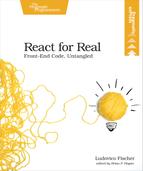Book Description
When traditional web development techniques don't cut it, try React. Use React to create highly interactive web pages faster and with fewer errors. With a little JavaScript experience under your belt, you'll be up and running in no time creating dynamic web applications. Craft isolated components that make your apps easier to develop and maintain, with plenty of guidance on best practices. Set up automated tests, and make pages render fast for your users. See how to use your React skills to integrate with other front-end technologies when needed.
Dive right into React by defining components, the basic building blocks of a React application. Integrate modern JavaScript language features such as classes and arrow functions in your app. Analyze the relationships in your data to isolate state, and sync the data model with what your users see.
Once you're familiar with how a React application works, organize your code base with modules. Configure a production build and deliver your app as efficiently as possible with Webpack. Master testing with React-specific advice and tools to catch the most bugs with the least amount of code. Learn the basics of the Redux library. Define actions and manage an immutable central state with reducers, then connect Redux to your React components to build even larger and more complex interfaces. Package your React code as a standalone widget so anyone can use it in their own applications. Reuse existing JavaScript code in your React components, and build a new React view on top of an existing data model shared with a legacy application.
When you finish this book, you'll be well on your way to solving your front-end problems with React.
What You Need:
Node.js 6.x or later, and a modern web browser.
